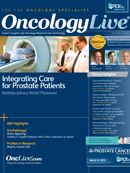Publication
Article
RARP Oncologic Outcomes Equivalent to Open Surgery for High-Risk Prostate Tumors
Author(s):
A novel retrospective study comparing robot-assisted radical prostatectomy and radical retropubic prostatectomy, in men with high-risk prostate cancer, found equivalent oncologic outcomes.
In a novel retrospective study comparing robot-assisted radical prostatectomy (RARP) and radical retropubic prostatectomy (RRP), in men with high-risk prostate cancer, the authors found equivalent oncologic outcomes. Recurrence-free survival was similar at 2 years (84% and 79%) and at 4 years (68% and 66%) after RRP and RARP, respectively (log-rank, P = .53) among 410 men who were treated at the University of California San Francisco (UCSF) from 2002 and 2011.
Sanoj Punnen, MD, clinical fellow in the Department of Urology at UCSF, reported these results for colleagues along with Peter Carroll, MD, at the 2012 Society for Urologic Oncology annual meeting in Bethesda, Maryland.
Within the study cohort, 177 patients underwent RRP and 233 patients had received the robotic procedure. The mean patient age was 61.6 years. Median follow-up was 27 months, with a range of 2 to 112 months.
There were no between-group differences by surgical approach, pathological grade, stage, or positive margin rates. However, Punnen stated, there was a trend towards higher positive margin rates with RARP in the early experience of robotic surgery, but this rate is now equivalent to open surgery (Table).
Some other differences were observed between RRP and RARP. For example, RARP patients experienced less blood loss and more often underwent complete bilateral nerve sparing (54% RARP; 34% RRP, P < .01).
Although its adoption for urologic surgery has expanded significantly over the past decade, the use of robotic prostatectomy for patients with high-risk prostate tumors has remained under debate. This study provides reassurance that RARP may be a consideration for an additional group of men with prostate cancer. Therefore, the choice between open versus robotic surgery should depend on the experience and comfort level of the surgeon performing the procedure. It is well-performed surgery, whether robotic or open, that determines the outcome—not the technique or approach used.
Table. Positive Margin Rates Between Open and Robotic Surgery
Odds Ratio
95% Confidence Interval
P-value
Robot vs Open 2002-2006
5.05
1.02-25.0
0.05
Robot vs Open 2006-2011
0.64
0.29-1.41
0.27










